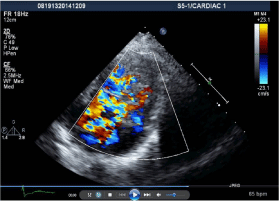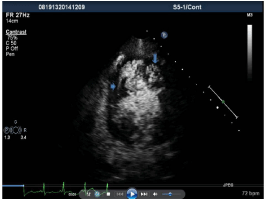
Case Report
Austin J Clin Cardiolog. 2020; 6(1): 1066.
A Rare Case of Left Ventricular Dysfunction-Left Ventricle Noncompaction–Misdiagnosed Entity
Ali A*, Vijaykumar JR and Manjunath CN
Sri Jayadeva Institute of Cardiovascular Sciences Bangalore, India
*Corresponding author: Ahmad Ali, Sri Jayadeva Institute of Cardiovascular Sciences Bangalore, India
Received: December 23, 2019; Accepted: January 21, 2020; Published: January 28, 2020
Abstract
Isolated ventricular noncompaction is an extremely rare cardiomyopathy; with prevalence of 0.014% in a group of patients referred to an echocardiography laboratory for abnormal findings or congestive heart failure not fully clarified. It is characterized by persistent embryonic myocardium morphology without associated cardiac abnormalities. Men appear to be more frequently affected; accounting for 56 to 82% of reported cases. Doppler echocardiogram is considered the reference method for diagnosis. Diagnosis remains difficult since there are similarities with other cardiac defects, clinical manifestations are nonspecific and echocardiographic criteria are not universally accepted. Treatment is directed towards important clinical manifestations (heart failure, arrhythmias and embolic events). We present a clinical case of severe congestive cardiac failure in previously healthy and asymptomatic 50 years old female, which was the initial presentation of an isolated ventricular noncompaction.
Learning points: Isolated ventricular noncompaction is a rare and recently described congenital cardiomyopathy. Its impact on morbidity and mortality is gaining importance as it is recognized with increasing frequency. An early, reliable diagnosis is crucial and echocardiography represents a prominent role. Treatment is directed towards its most important clinical implications, which include heart failure, arrhythmias and systemic embolic events. Heart transplantation is the only definitive treatment.
Keywords: LV noncompaction; LV dysfunction; Trabecular recesses; Hypertension
Introduction
Isolated ventricular noncompaction (IVNC) is a rare cardiomyopathy, until now, not fully clarified. It is thought to result from an arrest of the compaction of loose myocardial meshwork during fetal development. It is generally associated with other congenital abnormalities such as obstruction of ventricular outflow tracts. IVNC is characterized by persistent embryonic myocardium morphology in the absence of other cardiac abnormalities. Engberding first described it in 1984 referring to a 33-year old woman with persistent “sinusoids” in the left ventricle as an isolated abnormality [1]. Most of the literature is based on a few case reports. Due to lack of pathophysiological characterization, IVNC has been unspecifically assigned to a heterogeneous group of “unclassified cardiomyopathy”. As a consequence, diagnosis is frequently missed, with important negative prognostic implications for these patients.
Case Report
Fifty years old, female, diagnosed outside as hypertension since 2 years on treatment, presented tothe emergency department with history of swelling of lower limbs and progressive dyspnea. ECG showed Left ventricular hypertrophy with nonspecific ST-T wave changes. She was diagnosed as hypertensive heart disease with moderate LV dysfunction with possibility of acute coronary syndrome. She was started on angiotensin-converting enzyme (ACE) inhibitors. Routine investigations including cardiac enzymes were normal. Chest x-ray demonstrated increased heart-thorax index with pulmonary venous hypertension. A new echocardiogram (Figure 1) demonstrated exuberant thickening and trabeculation of the lateral and posterior walls of the apical half of the left ventricle with two distinct myocardial layers: a normal compact (C) epicardium and a thickened non-compact (NC) endocardium. The ratio between NC endocardium and C epicardium =2.2 (measured at end systole in parasternal short axis view). Color flow imaging demonstrated flow within these spongiform recesses giving a “Swiss cheese like” appearance (Figure 2). Left ventricle cavity was dilated and presented diffuse hypo kinesis and an ejection fraction of 40%. No additional abnormalities were found. These findings were consistent with the diagnosis of IVNC. Contrast echocardiogram revealed multiple sinusoidal cavities within the spongy myocardium confirming noncompaction of LV (Figure 3).

Figure 1: 2D TTE apical four chamber view arrows showing noncompacted
endocardium.

Figure 2: 2D TTE short axis view showing swiss cheese like appearance of
noncompated endocardium with blood entering the sinusoids.

Figure 3: Contrast echo showing multiple sinusoidal cavities within the
spongy myocardium.
Discussion
IVNC is considered a rare disease, its prevalence was 0,014% in a group of patients referred to an echocardiography laboratory for abnormal findings or congestive heart failure [2]. Men appear to be more frequently affected, accounting for 56 to 82% of reported cases [2,3]. The initial series published were related to pediatric population, but more recently there have been some cases described in adults [1-4]. IVNC is considered a congenital cardiomyopathy caused by intrauterine arrest of myocardial development. During early embryonic development, in the first months of intrauterine life the myocardium consists of a meshwork of loosely interwoven muscle fibres. In this spongy conformation, trabeculae alternate with recesses that communicate with the ventricular cavity to provide blood supply to the myocardium. Between the 5th and the 8th week of intrauterine development, when coronary circulation develops, ventricular myocardium becomes gradually compacted and those recesses turn into capillaries [3,5]. Left ventricle is uniformly affected, while right ventricle involvement is referred in less than one-half of the patients [3].Clinical manifestations of IVNC are non-specific. Although it is a congenital disease, the onset of symptoms is quite variable and may even occur at an advanced age. One of the most common manifestations of IVNC is a progressive left ventricular dysfunction, which may cause heart failure. Structural myocardial changes, consequent microvascular dysfunction and sub endocardial perfusion defects, even in the absence of coronary disease, may contribute either to ventricular dysfunction or arrhythmias [2,3,5,6]. Atrial fibrillation and ventricular tachyarrhythmia’s are the most frequent arrhythmias described. Sudden cardiac arrest occurred in about 47% of patients with IVNC [2-4]. Other electrocardiographic abnormalities found in most patients include left ventricular hypertrophy, ST segment changes, inverted T wave, intraventricular conduction defect and AV block [2,3,5,6].
Embolic events resulting either from atrial fibrillation or from formation of thrombi in the ventricular trabeculae may occur quite frequently. Cerebrovascular accidents, transient ischemic attacks and mesenteric infarction related to IVNC have been described in the literature [2,3,5]. To date, the diagnostic criteria of LVNC is largely based on 2D transthoracic echocardiogram. Three sets of diagnostic criteria have been proposed. Criteria proposed by Chin et al include: the compact layer to total myocardial thickness ratio is <0.5 in enddiastole in apical or parasternal short axis views. Criteria proposed by Jenni et al include: the ratio of no compacted to compacted myocardium in parasternal short axis view is >2 at end systole with prominent trabeculations and deep intertrabecular spaces that are perfused by intraventricular blood demonstrated by Doppler imaging, in the absence of other congenital heart disease. Finally, criteria proposed by Stoll Berger et al include: >3 trabeculations protruding from the left ventricular free wall apically to the papillary muscles, with the intertrabecular spaces perfused from the left ventricular cavity demonstrated by Doppler imaging. However, Kohli et al have called these criteria into question, with a study that showed that only 30% of LVNC met the requirements of all 3 diagnostic approaches [7-10].
Diagnosis of IVNC remains sometimes difficult and often presents with overlapping findings to other heart muscle diseases like dilated cardiomyopathy (DCM) and hypertrophic cardiomyopathy (HCM) [7]. In this clinical case diagnosis was primarily established by echocardiogram according to the all three Criteria defined. Both images obtained by echocardiogram and contrast echo were suggestive of IVNC. Treatment of IVNC is not specific and is directed. toward its three most important clinical implications: heart failure, cardiac arrhythmias and embolic events. Appropriate treatment for heart failure is essential and is similar to that of other causes which include diuretics, β-blockers and ACE inhibitors [3,5,8]. If standard treatment for heart failure is unsuccessful, heart transplantation may be considered as the only therapeutic possibility [3,5,8].
Some authors suggest that assessment of arrhythmias by electrophysiological study and 24-hour Holter ECG monitoring should be performed at the initial assessment and then annually [5]. For patients with arrhythmia, either symptomatic or not, antiarrhythmic drugs are recommended. Some authors have used a biventricular pacemaker [5,9]. Attending to the risk of cardiac sudden death, implantable cardioverter-defibrillator (ICD) may have a role in these patients [5,9]. Long-term prophylactic anticoagulation is recommended for all patients with IVNC regardless the identification of intracardiac thrombus [2,3,5,8]. Prognosis is widely variable. Some patients remain asymptomatic throughout their lives, while others show a rapid deterioration of the cardiac function, causing early death [5,7]. In fact, about 47-60% of symptomatic patients require heart transplantation in the first 6 years after diagnosis [2,3,5,8]. Asymptomatic patients, identified through routine or screening echocardiographic evaluation, have a clearly better prognosis [3]. Enlarged left atrium, left ventricular cavity dilatation, symptomatic heart failure class III-IV New York Heart Association (NYHA), persistent ventricular tachycardia, atrial fibrillation and branch block are bad prognosis criteria [2,5,9]. These high-risk patients have unstable clinical course and should be treated aggressively including early consideration of implantable cardioverter-defibrillator (ICD) or heart transplant.
References
- Engberding R, Bender F. Identification of a rare congenital anomaly of the myocardium by two-dimensional echocardiography: persistence of isolated myocardial sinusoids. Am J Cardiol. 1984; 53: 1733-1734.
- Oechslin EN, Attenhofer Jost CH, Rojas JR, Kaufmann PA, Jenni R. Longterm follow-up of 34 adults with isolated left ventricular noncompaction: a distinct cardiomyopathy with poor prognosis. J Am Coll Cardiol. 2000; 36: 493-500.
- Ritter M, Oechslin E, Sutsch G, Attenhofer C, Schneider J, Jenni R. Isolated Noncompaction of myocardium in adults. Mayo Clinic Proc. 1997; 72: 26-31.
- Rigopoulos A, Rizos IK, Aggeli C, Kloufetos P, Papacharalampous X, Stefanadis C, et al. Isolated left ventricular noncompaction: an unclassified cardiomyopathy with severe prognosis in adults. Cardiology. 2002; 98: 25-32.
- Weiford B, Subbarao V, Mulhern K. Noncompaction of ventricularmyocardium. Circulation. 2004; 109: 2965-2971.
- Ichida F, Hamamichi Y, Miyawaki T, Ono Y, Kamiya T, Akagi T, et al. Clinical features of isolated noncompaction of the ventricular myocardium: Long-term clinical course, hemodynamic properties, and genetic background. J Am Coll Cardiol.1999; 34: 233-240.
- Jenni R, Oechslin E, Schneider J, Attenhofer C, Kaufmann P. Echocardiographic and pathoanatomical characteristics of isolated left ventricular non-compaction: a step towards classification as a distinct cardiomyopathy. Heart. 2001; 86: 666-671.
- Jenni R, Oechslin EN, Loo B van der. Isolated ventricular noncompaction of the myocardium in adults. Heart. 2007; 93: 11-15.
- Lofiego C, Biagini E, Pasquale F, Ferlito M, Rocchi G, Perugini E, et al. Wide spectrum of presentation and variable outcomes of isolated left ventricular non-compaction. Heart. 2007; 93: 65-71.
- Kohli SK, Pantazis AA, Shah JS, Adeyemi B, Jackson G, McKenna WJ, et al. Diagnosis of left-ventricular non-compaction in patients with left-ventricular systolic dysfunction: time for a reappraisal of diagnostic criteria? Eur Heart J. 2008; 29: 89-95.